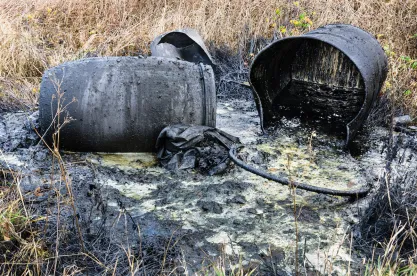After a more than 26 year hiatus, on July 1, 2022, the Superfund chemical excise tax (the “Superfund Chemical Tax”) will again become effective. This excise tax, reinstated by the passage of the Infrastructure Investment and Jobs Act,[1] is imposed on manufacturers, producers, and importers of certain chemicals and chemical substances. As discussed below, the re-establishment of this tax may have significant financial, administrative, and operational impacts; thus, it is crucial that businesses potentially subject to this tax understand its applicability, obligations, and exceptions, for tax year 2022 and beyond.
Even for those who have dealt with the first iteration of this tax, there are many material differences in the resurrected tax regime, including the applicable tax rates on chemicals and the threshold for determining which chemical substances are taxable.
Background and Purpose
The original Superfund Chemical Tax became effective in 1980 for the purpose of funding what was, at the time, the newly established Hazardous Substance Response Trust or “Superfund” – a financial trust created under the Comprehensive Environmental Response, Compensation, and Liability Act of 1980 (“CERCLA”) to finance, among other things, government-led cleanup and remediation of hazardous waste sites. Since its inception, the Superfund has received revenue from several sources, including taxes on crude oil and chemicals, corporate environmental taxes, appropriations from the general fund, fines, penalties, and recoveries from responsible parties under CERCLA, and interest accrued on the balance of the fund. From 1980 through December 31, 1995 (when the original Superfund Chemical Tax expired), taxes accounted for 68% of the fund’s revenues.[2]
The new Superfund Chemical Tax, which is set to expire on December 31, 2031, unless otherwise extended, is estimated to generate $14.5B in fund revenue over the next decade at an average of $1.44B annually.[3]
Applicability
The Superfund Chemical Tax is comprised of two main regimes, a tax on chemicals[4] and a tax on chemical substances.[5]
The tax on chemicals, under Section 4661 of the IRC, applies to the sale of any “taxable chemical” by a manufacturer, producer, or importer of such chemical. A “taxable chemical” is any of the 42 chemicals listed in Section 4661. The applicable tax rate for each taxable chemical is also set forth in Section 4661 on a graduated, per-ton scale, ranging from a low of $0.44 per ton on potassium hydroxide to a high of $9.74 per ton on several common petrochemicals, such as benzene. These amounts are not indexed for inflation under the statute.
The tax on chemicals substances, under Section 4671, applies to the use or sale of a “taxable substance” by the importer of such substance. A “taxable substance” is defined as (i) the 50 substances listed in Section 4672, (ii) any substance that is comprised of more than 20% of a taxable chemical by weight or value, and (iii) any substance that the Internal Revenue Service (the “IRS”) adds to the list of taxable substances at the request of an importer or exporter.
The IRS was tasked with reviewing and updating the list of taxable substances in Section 4672 by applying the “20% by weight or value” formula. In December 2021, the IRS, through Notice 2021-66,[6] added 101 additional substances to the list of taxable substances; however, the IRS has not yet provided specific guidance as to the tax rate to be imposed on these newly listed substances. Notice 2021-66 also suspended the existing procedure (under Notice 89-61)[7] for an importer or exporter to petition the IRS to add or remove a substance from the list. Of note, the burden is on the taxpayer to furnish information sufficient to determine the composition of a taxable substance. The tax rate applied to substances for which insufficient information is provided by the taxpayer to determine their composition is 10% of the appraised value of the substance “as of the time such substance was entered into the United States for consumption, use, or warehousing.”[8] The Secretary is also given discretion to prescribe an individual rate in lieu of the 10% figure.[9]
Changes from Former Tax
The reinstated tax differs from its predecessor in several important respects. First, the per-ton rates imposed under Section 4661 represent an effective doubling of the prior rates that were applicable in 1995. Second, the number of taxable substances has more than tripled from those originally covered under the former version of the tax. Third, the threshold amounts for determining taxable substances has been lowered from 50% by weight or value to only 20% (as noted above). Finally, the flat rate applicable to substances for which insufficient information on composition is available also doubled, from 5% of the appraised value of the substance to 10% (as noted above).
Reporting and Registration
Taxpayers under either the taxable chemical or the taxable chemical substance regime are also subject to reporting and other compliance requirements. For example, these taxes must be reported on IRS Form 6627, which is attached to IRS Form 720. In addition, taxpayers will also eventually be required to make semi-monthly deposits to the IRS of at least 95% of the amount of their net tax liability for the period in order to satisfy their Superfund Chemical Tax obligations. However, recently released Notice 2022-15[10] provides some relief from those deposit requirements through the first calendar quarter of 2023.
While there are generally no registration requirements imposed for payment of the Superfund Chemical Tax, registration is required for taxpayers seeking to benefit from the exceptions provided for under Sections 4662(b)(10) and 4662(c)(2).
Exceptions, Exemptions, Refunds and Credits
There are several significant exceptions to the Superfund Chemical Tax.
For taxable chemicals, the exceptions include methane or butane used as fuel, substances used in the production of fertilizer, sulfuric acid produced as a byproduct of air pollution control, substances derived from coal, substances used in the production of motor fuel, substances having transitory presence during refining process, xylene, recycled chromium, cobalt, and nickel, substances used in the production of animal feed, and hydrocarbon streams containing mixtures of organic taxable chemicals.
For taxable substances, there is also an exception for any taxable substance for which a tax is imposed on such sale or use under Section 4611 or Section 4661. In addition, there is an exemption for the export of chemicals otherwise taxable under Section 4661, if properly substantiated. There are also refunds and credits available for, among other things, chemicals used in the manufacture of any other substance that is a taxable chemical, certain chemicals used to make fertilizer, and chemicals used as a qualified fuel substance, or used in the production of animal feed.
Take Away
Given the decades that have passed since the Superfund Chemical Tax was last in effect, many companies may find that they no longer have the institutional knowledge and experience they once relied on for compliance with the Superfund Chemical Tax regime. Regardless, given the complex nature of the tax, the significant changes the mechanics of the tax have undergone, the burdens that have shifted to the taxpayer, and perhaps most importantly, the effective date of the tax looming on July 1, 2022, all companies potentially subject to this tax should, as early as practicable, become intimately familiar with the applicable body of law and accompanying IRS guidance (as it develops).
Due to the complex nature of the tax, and the potential impact on operations (e.g., administration, information technology, and supply chain, etc.), companies assessing their internal systems to gauge compliance preparedness may need to undertake a detailed, granular level review of the chemicals, chemical substances, and products the company manufactures, produces, or imports for sale or use, to understand if they are subject to the Superfund Chemical Tax and, if so, how to report, remit taxes, and/or register for an exception. Preparation may also require an evaluation of internal data collection processes to ensure their compatibility with the precision the Superfund Chemical Tax demands. Companies may also want to consider utilizing information technology and automation to maximize their efficiency and proper compliance. A company’s tax department may need to synchronize its data collection and compliance obligations with other internal departments and business operations to ensure no gaps develop that could lead to liability for non-compliance and exposure to penalties.
IRS Fact Sheet
On June 24, 2022, the IRS released a fact sheet (FS-2022-31) on the reinstatement of excise taxes on Superfund chemicals. It is in question-and-answer format and, among other things, provides information on definitions, changes to the list of taxable substances, calculating the section 4661 and section 4671 taxes, and the procedures for reporting and for depositing payments.
——————————-
FOOTNOTES
[1] Public Law 117-58, 135 Stat. 429 (November 15, 2021).
[2] United States Government Accountability Office, Superfund: Funding and Reported Costs of Enforcement and Administration Activities, GAO-08-841R (July 18, 2008).
[3] Joint Committee on Taxation, Estimated Revenue Effects of the Provisions of Division H of an Amendment in the Nature of a Substitute to H.R. 3684 (Aug. 2, 2021).
[4] See §4661 of the Internal Revenue Code of 1986, as amended (the “IRC”). All section references herein are to the IRC, unless otherwise noted.
[5] See IRC §4671.
[6] IRS, Superfund; Initial List of Taxable Substances; Registration; Procedural Rules; Request for Comments; Suspension of Notice 89-61, Notice 2021-66, 2021-52 I.R.B. 901. https://www.irs.gov/pub/irs-drop/n-21-66.pdf.
[7] IRS, Imported Substances; Rules for Filing a Petition, Notice 89-61, 1989-21 I.R.B. 25. https://omb.report/icr/201308-1545-022/doc/41626401.
[8] IRC §4671(b)(2).
[9] IRC §4671(b)(3).
[10] IRS, Temporary Relief from Penalty for Failure to Deposit Superfund Chemical Taxes, Notice 2022-15, https://www.irs.gov/pub/irs-drop/n-22-15.pdf.
Thomas T. Multari also contributed to this article.




 />i
/>i

